2011 NISSAN CUBE child seat
[x] Cancel search: child seatPage 40 of 345
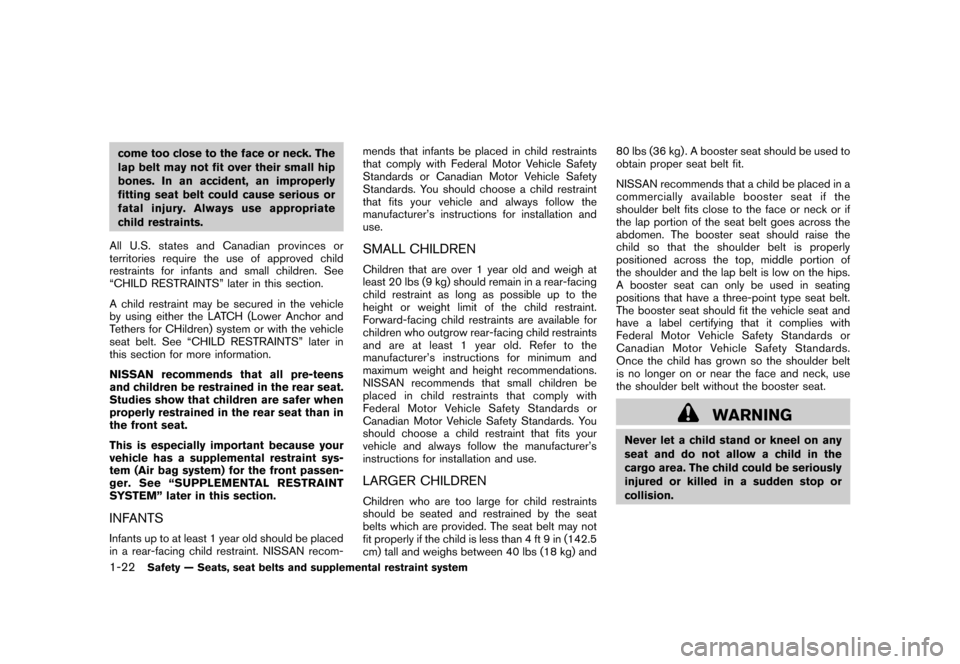
Black plate (36,1)
Model "Z12-D" EDITED: 2011/ 2/ 18
come too close to the face or neck. The
lap belt may not fit over their small hip
bones. In an accident, an improperly
fitting seat belt could cause serious or
fatal injury. Always use appropriate
child restraints.
All U.S. states and Canadian provinces or
territories require the use of approved child
restraints for infants and small children. See
“CHILD RESTRAINTS” later in this section.
A child restraint may be secured in the vehicle
by using either the LATCH (Lower Anchor and
Tethers for CHildren) system or with the vehicle
seat belt. See “CHILD RESTRAINTS” later in
this section for more information.
NISSAN recommends that all pre-teens
and children be restrained in the rear seat.
Studies show that children are safer when
properly restrained in the rear seat than in
the front seat.
This is especially important because your
vehicle has a supplemental restraint sys-
tem (Air bag system) for the front passen-
ger. See “SUPPLEMENTAL RESTRAINT
SYSTEM” later in this section.INFANTSInfants up to at least 1 year old should be placed
in a rear-facing child restraint. NISSAN recom- mends that infants be placed in child restraints
that comply with Federal Motor Vehicle Safety
Standards or Canadian Motor Vehicle Safety
Standards. You should choose a child restraint
that fits your vehicle and always follow the
manufacturer’s instructions for installation and
use.
SMALL CHILDRENChildren that are over 1 year old and weigh at
least 20 lbs (9 kg) should remain in a rear-facing
child restraint as long as possible up to the
height or weight limit of the child restraint.
Forward-facing child restraints are available for
children who outgrow rear-facing child restraints
and are at least 1 year old. Refer to the
manufacturer’s instructions for minimum and
maximum weight and height recommendations.
NISSAN recommends that small children be
placed in child restraints that comply with
Federal Motor Vehicle Safety Standards or
Canadian Motor Vehicle Safety Standards. You
should choose a child restraint that fits your
vehicle and always follow the manufacturer’s
instructions for installation and use.LARGER CHILDRENChildren who are too large for child restraints
should be seated and restrained by the seat
belts which are provided. The seat belt may not
fit properly if the child is less than 4 ft 9 in (142.5
cm) tall and weighs between 40 lbs (18 kg) and80 lbs (36 kg) . A booster seat should be used to
obtain proper seat belt fit.
NISSAN recommends that a child be placed in a
commercially availabl
eboosterseatifthe
shoulder belt fits close to the face or neck or if
the lap portion of the seat belt goes across the
abdomen. The booster seat should raise the
child so that the shoulder belt is properly
positioned across the top, middle portion of
the shoulder and the lap belt is low on the hips.
A booster seat can only be used in seating
positions that have a three-point type seat belt.
The booster seat should fit the vehicle seat and
have a label certifying that it complies with
Federal Motor Vehicle Safety Standards or
Canadian Motor Vehicle Safety Standards.
Once the child has grown so the shoulder belt
is no longer on or near the face and neck, use
the shoulder belt without the booster seat.
WARNING
Never let a child stand or kneel on any
seat and do not allow a child in the
cargo area. The child could be seriously
injured or killed in a sudden stop or
collision.
1-22
Safety — Seats, seat belts and supplemental restraint system
Page 41 of 345
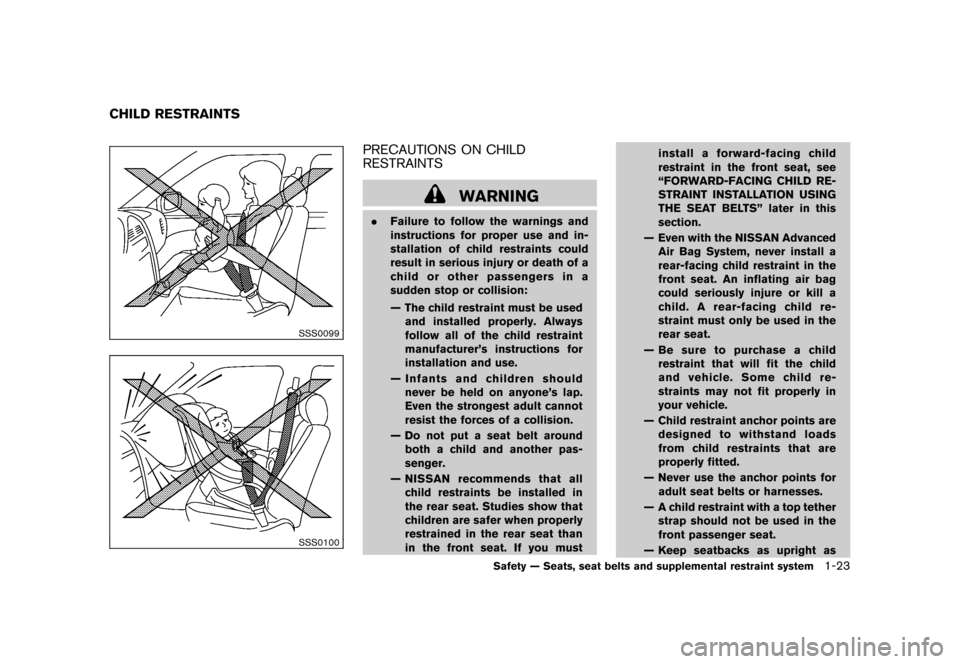
Black plate (37,1)
Model "Z12-D" EDITED: 2010/ 9/ 27
SSS0099SSS0100
PRECAUTIONS ON CHILD
RESTRAINTS
WARNING
.Failure to follow the warnings and
instructions for proper use and in-
stallation of child restraints could
result in serious injury or death of a
child or other passengers in a
sudden stop or collision:
— The child restraint must be used
and installed properly. Always
follow all of the child restraint
manufacturer’s instructions for
installation and use.
— Infants and children should never be held on anyone’s lap.
Even the strongest adult cannot
resist the forces of a collision.
— Do not put a seat belt around both a child and another pas-
senger.
— NISSAN recommends that all child restraints be installed in
the rear seat. Studies show that
children are safer when properly
restrained in the rear seat than
in the front seat. If you must install a forward-facing child
restraint in the front seat, see
“FORWARD-FACING CHILD RE-
STRAINT INSTALLATION USING
THE SEAT BELTS” later in this
section.
— Even with the NISSAN Advanced Air Bag System, never install a
rear-facing child restraint in the
front seat. An inflating air bag
could seriously injure or kill a
child. A rear-facing child re-
straint must only be used in the
rear seat.
—Besuretopurchaseachild restraint that will fit the child
and vehicle. Some child re-
straints may not fit properly in
your vehicle.
— Child restraint anchor points are designed to withstand loads
from child restraints that are
properly fitted.
— Never use the anchor points for adult seat belts or harnesses.
— A child restraint with a top tether strap should not be used in the
front passenger seat.
— Keep seatbacks as upright as
CHILD RESTRAINTS
Safety — Seats, seat belts and supplemental restraint system
1-23
Page 42 of 345
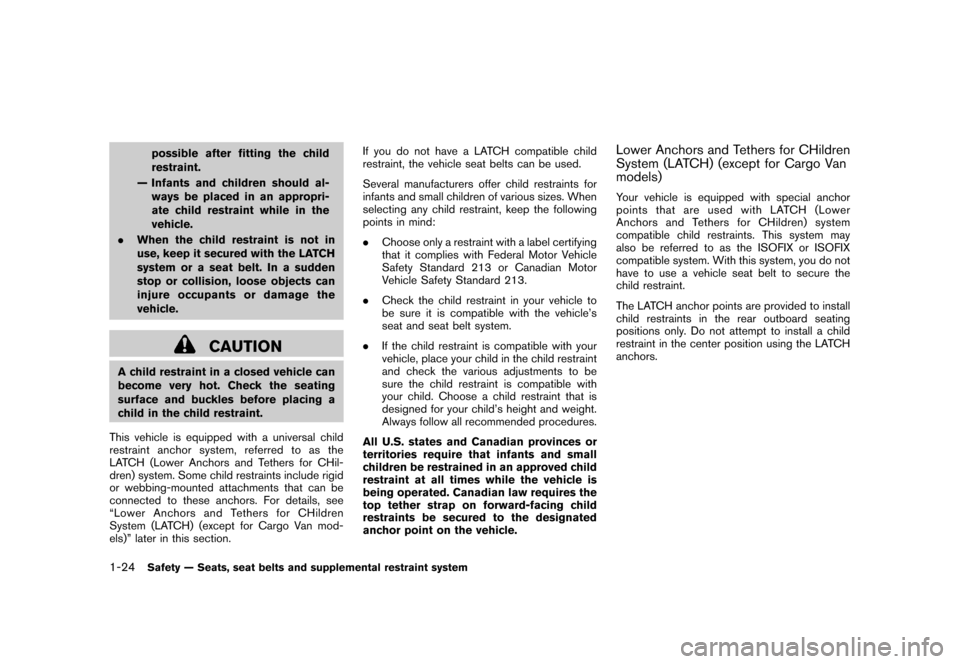
Black plate (38,1)
Model "Z12-D" EDITED: 2010/ 9/ 27
possible after fitting the child
restraint.
— Infants and children should al- ways be placed in an appropri-
ate child restraint while in the
vehicle.
. When the child restraint is not in
use, keep it secured with the LATCH
system or a seat belt. In a sudden
stop or collision, loose objects can
injure occupants or damage the
vehicle.
CAUTION
A child restraint in a closed vehicle can
become very hot. Check the seating
surface and buckles before placing a
child in the child restraint.
This vehicle is equipped with a universal child
restraint anchor system, referred to as the
LATCH (Lower Anchors and Tethers for CHil-
dren) system. Some child restraints include rigid
or webbing-mounted attachments that can be
connected to these anchors. For details, see
“Lower Anchors and Tethers for CHildren
System (LATCH) (except for Cargo Van mod-
els)” later in this section. If you do not have a LATCH compatible child
restraint, the vehicle seat belts can be used.
Several manufacturers offer child restraints for
infants and small children of various sizes. When
selecting any child restraint, keep the following
points in mind:
.
Choose only a restraint with a label certifying
that it complies with Federal Motor Vehicle
Safety Standard 213 or Canadian Motor
Vehicle Safety Standard 213.
. Check the child restraint in your vehicle to
be sure it is compatible with the vehicle’s
seat and seat belt system.
. If the child restraint is compatible with your
vehicle, place your child in the child restraint
and check the various adjustments to be
sure the child restraint is compatible with
your child. Choose a child restraint that is
designed for your child’s height and weight.
Always follow all recommended procedures.
All U.S. states and Canadian provinces or
territories require that infants and small
children be restrained in an approved child
restraint at all times while the vehicle is
being operated. Canadian law requires the
top tether strap on forward-facing child
restraints be secured to the designated
anchor point on the vehicle.
Lower Anchors and Tethers for CHildren
System (LATCH) (except for Cargo Van
models)Your vehicle is equipped with special anchor
points that are used with LATCH (Lower
Anchors and Tethers for CHildren) system
compatible child restraints. This system may
also be referred to as the ISOFIX or ISOFIX
compatible system. With this system, you do not
have to use a vehicle seat belt to secure the
child restraint.
The LATCH anchor points are provided to install
child restraints in the rear outboard seating
positions only. Do not attempt to install a child
restraint in the center position using the LATCH
anchors.
1-24
Safety — Seats, seat belts and supplemental restraint system
Page 43 of 345
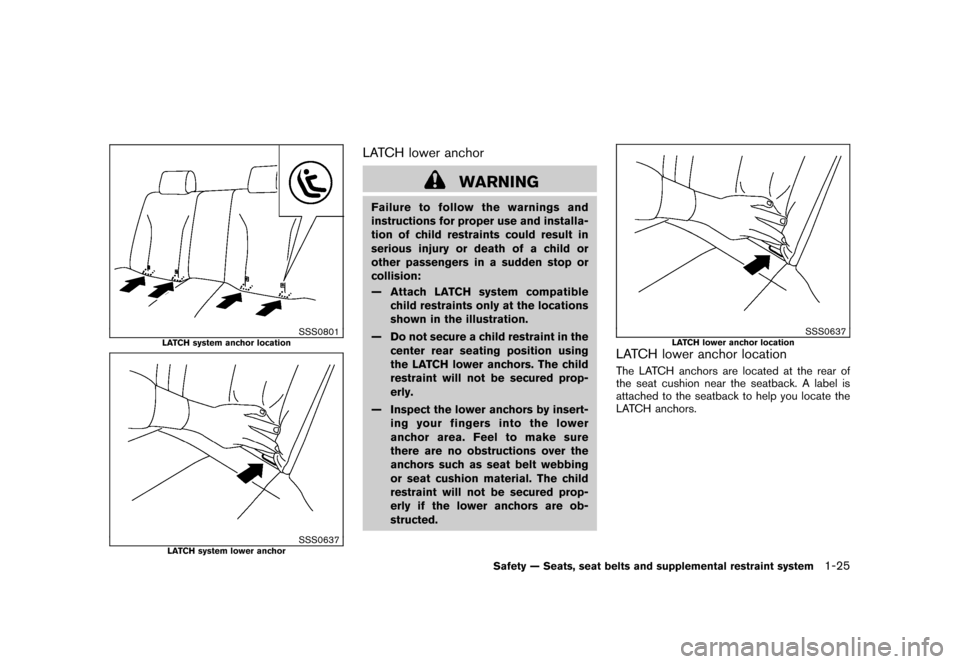
Black plate (39,1)
Model "Z12-D" EDITED: 2010/ 9/ 27
SSS0801
LATCH system anchor location
SSS0637
LATCH system lower anchor
LATCH lower anchor
WARNING
Failure to follow the warnings and
instructions for proper use and installa-
tion of child restraints could result in
serious injury or death of a child or
other passengers in a sudden stop or
collision:
— Attach LATCH system compatiblechild restraints only at the locations
shown in the illustration.
— Do not secure a child restraint in the center rear seating position using
the LATCH lower anchors. The child
restraint will not be secured prop-
erly.
— Inspect the lower anchors by insert- ing your fingers into the lower
anchor area. Feel to make sure
there are no obstructions over the
anchors such as seat belt webbing
or seat cushion material. The child
restraint will not be secured prop-
erly if the lower anchors are ob-
structed.
SSS0637
LATCH lower anchor location
LATCH lower anchor locationThe LATCH anchors are located at the rear of
the seat cushion near the seatback. A label is
attached to the seatback to help you locate the
LATCH anchors.
Safety — Seats, seat belts and supplemental restraint system
1-25
Page 44 of 345
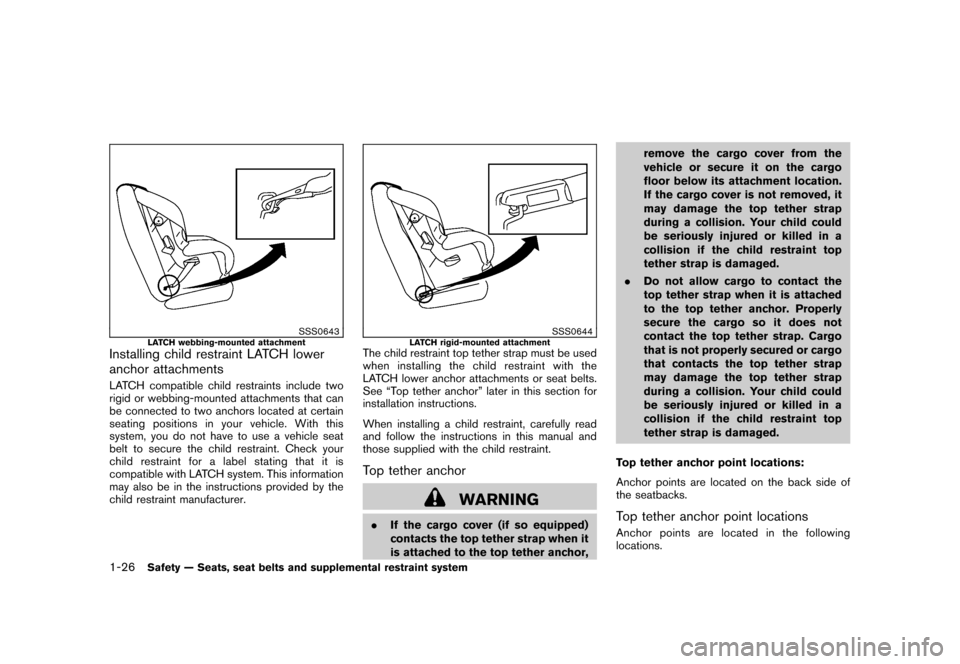
Black plate (40,1)
Model "Z12-D" EDITED: 2010/ 9/ 27
SSS0643
LATCH webbing-mounted attachment
Installing child restraint LATCH lower
anchor attachmentsLATCH compatible child restraints include two
rigid or webbing-mounted attachments that can
be connected to two anchors located at certain
seating positions in your vehicle. With this
system, you do not have to use a vehicle seat
belt to secure the child restraint. Check your
child restraint for a label stating that it is
compatible with LATCH system. This information
may also be in the instructions provided by the
child restraint manufacturer.
SSS0644
LATCH rigid-mounted attachment
The child restraint top tether strap must be used
when installing the child restraint with the
LATCH lower anchor attachments or seat belts.
See “Top tether anchor” later in this section for
installation instructions.
When installing a child restraint, carefully read
and follow the instructions in this manual and
those supplied with the child restraint.Top tether anchor
WARNING
. If the cargo cover (if so equipped)
contacts the top tether strap when it
is attached to the top tether anchor, remove the cargo cover from the
vehicle or secure it on the cargo
floor below its attachment location.
If the cargo cover is not removed, it
may damage the top tether strap
during a collision. Your child could
be seriously injured or killed in a
collision if the child restraint top
tether strap is damaged.
. Do not allow cargo to contact the
top tether strap when it is attached
to the top tether anchor. Properly
secure the cargo so it does not
contact the top tether strap. Cargo
that is not properly secured or cargo
that contacts the top tether strap
may damage the top tether strap
during a collision. Your child could
be seriously injured or killed in a
collision if the child restraint top
tether strap is damaged.
Top tether anchor point locations:
Anchor points are located on the back side of
the seatbacks.
Top tether anchor point locationsAnchor points are located in the following
locations.
1-26
Safety — Seats, seat belts and supplemental restraint system
Page 45 of 345
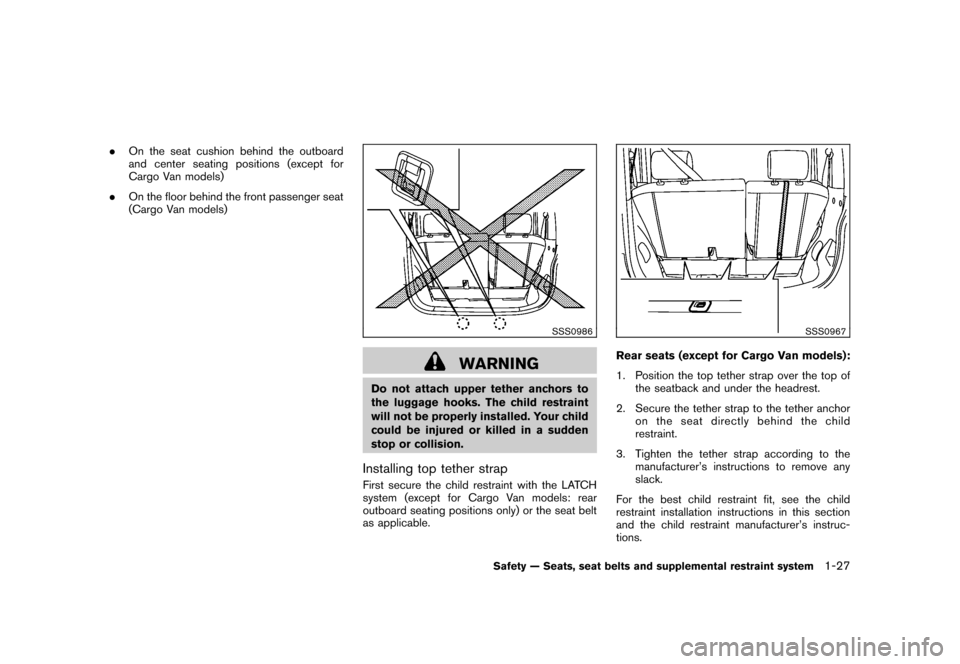
Black plate (41,1)
Model "Z12-D" EDITED: 2010/ 9/ 27
.On the seat cushion behind the outboard
and center seating positions (except for
Cargo Van models)
. On the floor behind the front passenger seat
(Cargo Van models)
SSS0986
WARNING
Do not attach upper tether anchors to
the luggage hooks. The child restraint
will not be properly installed. Your child
could be injured or killed in a sudden
stop or collision.Installing top tether strapFirst secure the child restraint with the LATCH
system (except for Cargo Van models: rear
outboard seating positions only) or the seat belt
as applicable.
SSS0967
Rear seats (except for Cargo Van models):
1. Position the top tether strap over the top of
the seatback and under the headrest.
2. Secure the tether strap to the tether anchor on the seat directly behind the child
restraint.
3. Tighten the tether strap according to the manufacturer’s instructions to remove any
slack.
For the best child restraint fit, see the child
restraint installation instructions in this section
and the child restraint manufacturer’s instruc-
tions.
Safety — Seats, seat belts and supplemental restraint system
1-27
Page 46 of 345
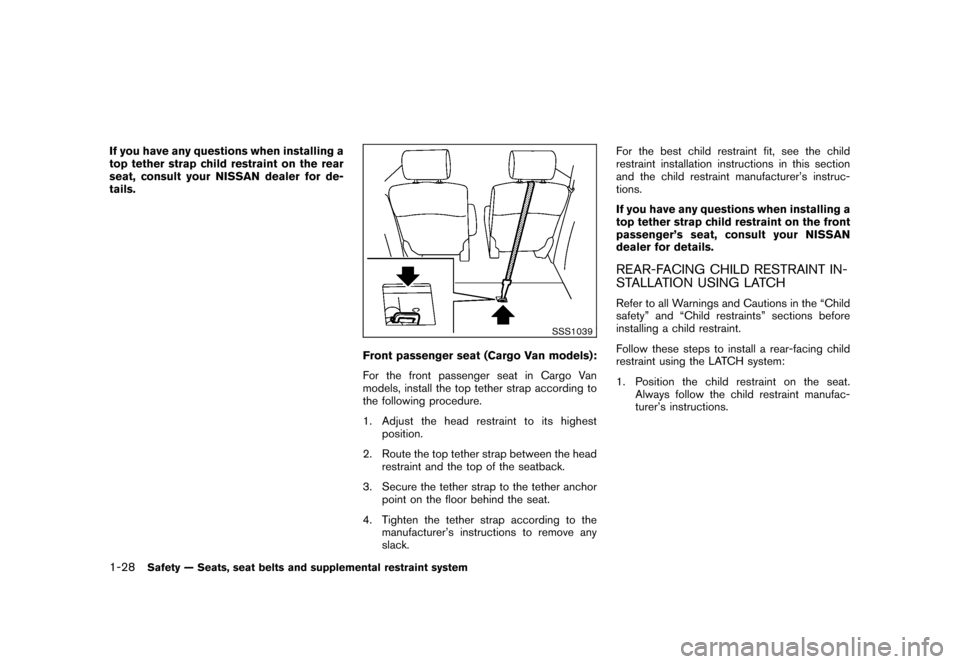
Black plate (42,1)
Model "Z12-D" EDITED: 2010/ 9/ 27
If you have any questions when installing a
top tether strap child restraint on the rear
seat, consult your NISSAN dealer for de-
tails.
SSS1039
Front passenger seat (Cargo Van models):
For the front passenger seat in Cargo Van
models, install the top tether strap according to
the following procedure.
1. Adjust the head restraint to its highestposition.
2. Route the top tether strap between the head restraint and the top of the seatback.
3. Secure the tether strap to the tether anchor point on the floor behind the seat.
4. Tighten the tether strap according to the manufacturer’s instructions to remove any
slack. For the best child restraint fit, see the child
restraint installation instructions in this section
and the child restraint manufacturer’s instruc-
tions.
If you have any questions when installing a
top tether strap child restraint on the front
passenger’s seat, consult your NISSAN
dealer for details.
REAR-FACING CHILD RESTRAINT IN-
STALLATION USING LATCHRefer to all Warnings and Cautions in the “Child
safety” and “Child restraints” sections before
installing a child restraint.
Follow these steps to install a rear-facing child
restraint using the LATCH system:
1. Position the child restraint on the seat.
Always follow the child restraint manufac-
turer’s instructions.
1-28
Safety — Seats, seat belts and supplemental restraint system
Page 47 of 345
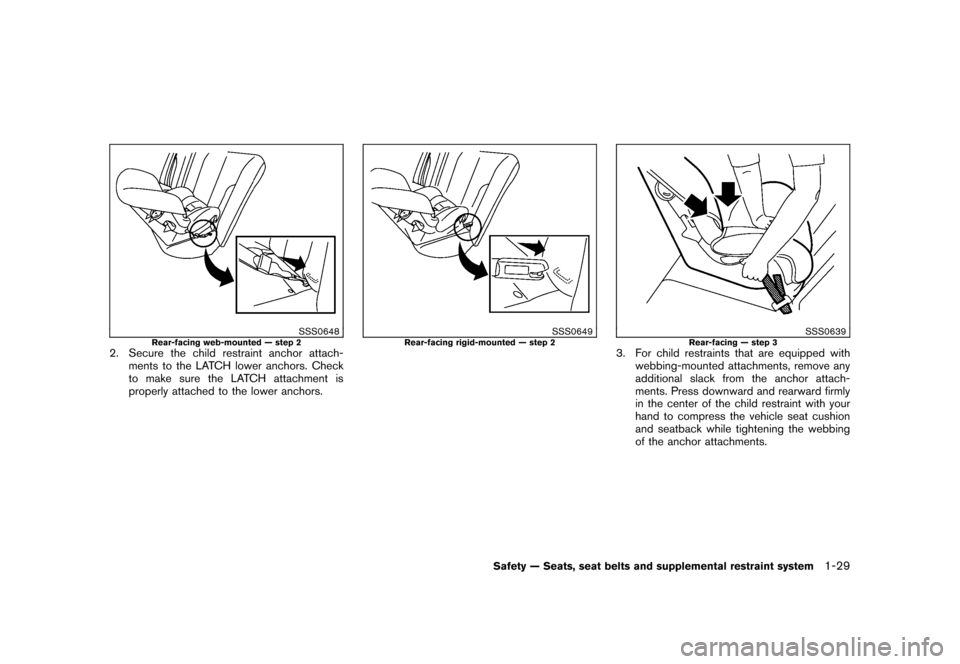
Black plate (43,1)
Model "Z12-D" EDITED: 2010/ 9/ 27
SSS0648
Rear-facing web-mounted — step 2
2. Secure the child restraint anchor attach-ments to the LATCH lower anchors. Check
to make sure the LATCH attachment is
properly attached to the lower anchors.
SSS0649
Rear-facing rigid-mounted — step 2
SSS0639
Rear-facing — step 3
3. For child restraints that are equipped withwebbing-mounted attachments, remove any
additional slack from the anchor attach-
ments. Press downward and rearward firmly
in the center of the child restraint with your
hand to compress the vehicle seat cushion
and seatback while tightening the webbing
of the anchor attachments.
Safety — Seats, seat belts and supplemental restraint system
1-29